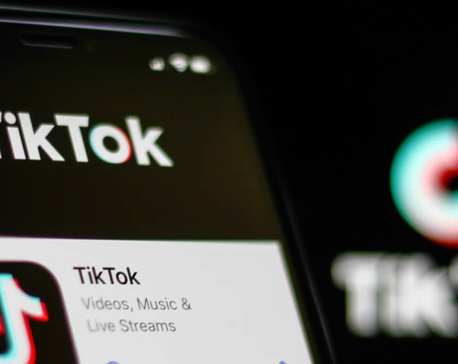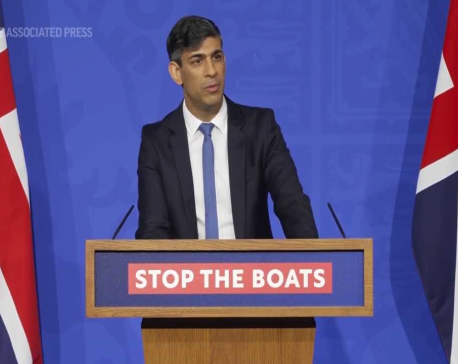
OR
In likely tight Canadian vote, deciding who governs could take weeks
Published On: October 16, 2019 09:46 PM NPT By: Reuters
OTTAWA, Oct 16: Opinion polls suggest no party will gain a majority of seats in the Canadian election on Oct. 21. That leaves the two frontrunners - Liberal Prime Minister Justin Trudeau and Conservative opposition leader Andrew Scheer - trying to govern with a minority. Six parties are contesting the election.
Here’s how events could play out after the vote:
IF ONE PARTY WINS A MAJORITY
If Trudeau wins a majority of the 338 seats in the House of Commons, he will stay on. A party needs at least 170 seats for a majority. The Liberals currently have 177 seats.
If Scheer wins a majority, he would take over as prime minister after a two-week transition period.
ONE PARTY WINS THE MOST SEATS BUT FALLS SHORT OF A MAJORITY
To govern Canada, a prime minister must show that he or she has the confidence of the House of Commons, the elected lower chamber of Parliament.
If the result is a minority, the incumbent prime minister has the opportunity to test their standing with a vote of confidence. This would be the case even if Trudeau wins fewer seats than Scheer.
“He is the prime minister until he resigns or is defeated in the House,” said Gerald Baier, a political science professor at the University of British Columbia.
If the Liberals win more seats than the Conservatives but fall short of a majority, Trudeau has several options.
With 160 seats or more, Liberal insiders say Trudeau will most likely govern as though he has a majority, effectively daring the opposition to bring him down in a confidence vote.
If the Liberals get fewer than 160 seats, he will seek an arrangement with the minority opposition New Democratic Party (NDP) or the Greens, who are also both left-leaning.
There is almost no chance of a formal coalition, where New Democrats would serve in a Trudeau cabinet. Canada has only ever had one coalition and that was in 1917, during World War I.
More likely is a deal whereby the NDP backs the Liberals in exchange for Trudeau committing to some of their priorities. The NDP helped keep Liberal minority governments in power from 1972-1974 and in 2005.
THE FIRST STEPS
If Trudeau decides to test the confidence of the House, he could first swear in a cabinet during a ceremony presided over by Governor General Julie Payette, the Canada-based representative of the head of state, Queen Elizabeth.
This does not have to happen immediately, especially if there are automatic recounts in some seats where the results are particularly tight.
Presenting a new cabinet “would be a way of signaling that he intends to keep governing,” said Professor Philippe Lagasse of Ottawa’s Carleton University. It is an optional step.
“All ministers currently retain their portfolios and it would not be necessary for him to swear a new cabinet prior to testing confidence,” added Lagasse.
Assuming Trudeau tries to govern either alone or with another party, he would then convene Parliament. This does not have to happen immediately, since the rules dictate Parliament only has to meet once a year.
That said, Trudeau will not wait forever. In 1979, the Conservatives won a minority of seats in June and did not bring Parliament back till October, the longest such gap in Canadian history.
IF TRUDEAU LOSES HIS FIRST VOTE OF CONFIDENCE
If Trudeau were to lose his first confidence vote, he could request another election but in all likelihood, the Governor General would then ask Scheer whether he could create a government, citing the need to avoid two elections in quick succession.
Scheer would, on paper, have more challenges, since the NDP says it will not work with him under any circumstances.
This leaves the separatist Bloc Quebecois, which seeks independence for the predominantly French-speaking province of Quebec. The idea of federal parties cooperating with the Bloc is especially sensitive and Scheer has said he would not strike a deal with them.
This would leave Scheer running a minority government by himself. Former Conservative Prime Minister Stephen Harper did just that for more than five years between 2006 and 2011, when he had two successive minorities, alternately cajoling and threatening other parties to make sure they did not bring him down. He won a majority in 2011.
IT COULD TAKE MONTHS TO CREATE A STABLE GOVERNMENT
The best example of how long the process could take comes from the 2017 electihere in the Canadian province of British Columbia, where the gap between election day and the creation of a new government stretched out to 52 days. That election used the same rule book as the federal vote.
You May Like This

Senate passes bill forcing TikTok’s parent company to sell or face ban, sends to Biden for signature
WASHINGTON, April 24: The Senate passed legislation Tuesday that would force TikTok’s China-based parent company to sell the social media... Read More...

UK Parliament approves Rwanda deportation bill, ending weeks of legislative stalemate
LONDON. April 23: British Prime Minister Rishi Sunak ‘s latest effort to send some migrants to Rwanda finally won approval... Read More...

Israeli military intelligence chief resigns over failure to prevent Oct. 7 attack
TEL AVIV, Israel (AP) — The head of Israel’s military intelligence directorate resigned on Monday over the failures surrounding Hamas’ unprecedented Oct. 7... Read More...




Just In
- Health ministry to conduct ‘search and vaccinate’ campaign on May 13
- Indian customs releases trucks carrying Nepali tea, halted across Kakarbhitta
- Silent period for by-election to begin from midnight
- SC issues short-term interim order to govt and TU not to take immediate action against TU legal advisor Khanal
- National consultation workshop advocates to scale up nutrition smart community in Nepal
- Patan High Court issues short-term interim order to halt selection process of NTB’s CEO
- NEPSE inches up 0.15 points; daily turnover increases to Rs 2.53 billion
- Bagmati Govt mandates tri-lingual signboards in offices














Leave A Comment